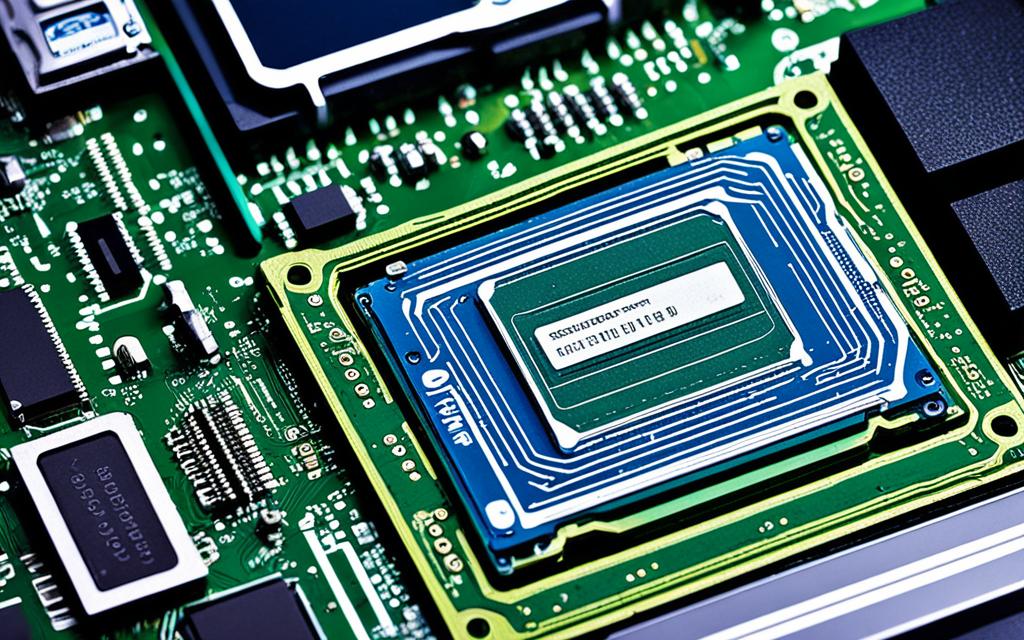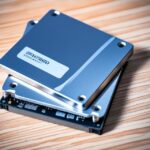Table of Contents
Understanding your computer’s storage system is crucial in today’s world. Knowing the difference between SSD (Solid State Drive) and HDD (Hard Disk Drive) can make your computer faster and last longer. SSDs are preferred for their speed and reliability. However, some people only think about how much data they can store. This leads to missed chances to make their computer better. As computers get more complex, identifying your SSD is key. This helps you make smart choices about upgrading. This guide will show you how to find out which SSD you have. It’s for both Windows and macOS users. You’ll learn simple ways to identify your SSD type. This makes your computer work more efficiently. There are additional tools and techniques available. They show the need for detailed info about your computer’s parts. This knowledge is vital for deciding on system upgrades and enhancing performance12..
Key Takeaways
- Understanding SSD vs HDD is crucial for system performance.
- Many users remember only the storage capacity of their SSDs.
- Multiple methods are available in Windows to identify SSDs.
- Windows 11 provides tools to differentiate between SSDs and HDDs.
- Most Macs predominantly use SSDs unless very old.
- Knowing your SSD type can lead to better upgrade decisions.
Introduction to SSDs
In today’s world, knowing about storage options matters a lot. SSDs, also known as solid-state drives, are changing how we store and get back data. They offer many advantages of SSDs due to their design, boosting both performance and how we use them.
What is an SSD?
An SSD stores data using non-volatile memory. This means it’s much faster at getting and saving data than traditional hard drives (HDDs). HDDs use spinning disks and are slower. SSDs don’t have moving parts, making them durable and reliable. They also start up operating systems and programs more quickly3. Knowing what an SSD is can really improve how your computer works.
The advantages of SSDs over HDDs
SSDs are way faster than HDDs, moving data at speeds between 100-600 Mb/sec4. This speed boost makes programs load faster and files easier to access, giving a big performance improvement. They also use less power, perfect for laptops3. Their toughness and reliability mean there’s less chance of losing your data, especially important when you’re moving around5.
Understanding the key differences between SSDs and HDDs
When comparing SSD vs HDD, the differences matter, especially in cost. SSDs usually cost more per GB but are worth it for their speed and sturdiness4. They use NAND flash memory, which can only be written to a certain number of times. This might limit performance as time goes on4. You should consider the pros and cons to choose the right storage for you.
How to find out what SSD I have
Finding out the type of SSD in your system can enlighten you about its speed and capacity. Windows has easy-to-use tools to check your drive type. This knowledge helps in understanding how best to use your computer.
Using the Defragment and Optimise Drives tool on Windows
The Windows defrag tool is a handy way to find out your drive’s type. Just type ‘defrag’ in the search bar and open the tool. It has a ‘Media type’ column that shows if your drives are SSDs or HDDs. This method is a simple way to discover your SSD type without getting into technical details.
Checking SSD type through Device Manager
Another method is using the Device Manager to check your SSD. Search for Device Manager, open it, and go to the ‘Disk Drives’ section. Here, you’ll find information about each drive, including the specific SSD model. This knowledge helps you understand more about your computer’s storage. It makes it easier to care for your SSD, which is faster and lasts longer than HDDs6.
Finding SSD information on Windows 11
Determining SSD information on Windows 11 can boost your system’s performance and upkeep. Use Windows PowerShell for a quick PowerShell SSD check. Or, use Task Manager for drive performance details.
Utilising Windows PowerShell for identifying drive types
To find SSD info in Windows 11, start Windows PowerShell. Type the command Get-PhysicalChip | Format-Table -AutoSize. This shows all physical drives and their types. The ‘MediaType’ column will tell if it’s an SSD or HDD. This method is direct and avoids the need for complex menus.
Using Task Manager to check drive performance
Task Manager also offers a way to learn about your SSD. Right-click the taskbar and open Task Manager. Go to the ‘Performance’ tab for details on your drives. This shows the drive type and live performance stats. It’s great for checking your Task Manager SSD performance.
Identifying SSDs on macOS
Knowing how to spot an SSD on macOS is key for users wanting better device performance. One easy way is to look at the About This Mac storage info via the Apple menu. It gives details on hardware specs and storage types quickly.
Accessing About This Mac for storage details
Start by clicking the Apple icon at your screen’s top-left. Then, choose ‘About This Mac’ from the menu. A window will appear showing important info like your processor, memory, and storage details. Here, you can easily tell if your drive is an SSD or something else. This knowledge is vital for maintaining great performance and dependability.
What to look for in the Storage section
In the ‘Storage’ tab of ‘About This Mac’, search for terms like ‘Flash Storage’ or ‘SSD’. This means your Mac has an SSD. It shows not just total storage space but also how much is used. Understanding this helps with upgrades and managing system resources well.
For a deeper dive, various resources exist. These include forums and guides on conducting a detailed macOS SSD check. Techniques to test drive performance can also boost your grasp of system abilities.
For additional knowledge on spotting SSDs in macOS, consider exploring detection techniques mentioned in online communities7.
Alternative methods for checking SSD status
Users have several alternative methods to check their SSD status beyond the usual tools. For Windows users, the Windows Disk Management feature is a good start. It gives a detailed look at installed drives, including their partitions and file systems. To use it, right-click ‘This PC’, select ‘Manage’, then go to ‘Disk Management’. This feature helps users monitor how their storage is being used and the state of their drive, which is crucial for understanding the SSD’s performance.
Using Disk Management for detailed drive properties
Disk Management reveals important details about your SSD. It keeps you up to date on its health and how much you’re using it. Checking your SSD regularly is wise as it helps you spot problems early. They could be due to TBW limits or wear and tear. Interestingly, SSDs usually have a lower failure rate than HDDs. A report by Backblaze in Q2 2022 showed SSDs had an Annualised Failure Rate (AFR) of only 0.92%. This shows why it’s so important to keep an eye on your SSD’s health.
Checking S.M.A.R.T. status on macOS
macOS users can keep an eye on their SSD through S.M.A.R.T. status. Go to ‘About This Mac’, click ‘System Report’, and then ‘Storage’ to see it. S.M.A.R.T. gives you a quick health check, showing if your SSD passes or fails. For more in-depth analysis, tools like Samsung Magician and Western Digital Dashboard are great. They provide detailed performance stats and monitoring tools8.
FAQ
What is the main difference between an SSD and an HDD?
SSDs and HDDs differ mainly in how they store data. SSDs use non-volatile memory, which means they don’t have moving parts. This makes them much faster at reading and writing data. In contrast, HDDs work with spinning disks and are slower because of their mechanical parts.
Why should I consider upgrading to an SSD?
Upgrading to an SSD makes your computer work faster. You’ll see shorter boot times, and your apps will load quickly. For those who carry their devices around, SSDs are great because they use less power and are smaller.
How can I easily identify my SSD or HDD type in Windows?
To find out if you have an SSD or HDD in Windows, use ‘Defragment and Optimise Drives’. Just search for ‘defrag’, open the tool, and look under ‘Media type’. It will show you what you have.
Is there a method to check my SSD status on macOS?
Yes, to see your SSD’s health on a Mac, go to ‘About This Mac’. Choose ‘System Report’ and then ‘Storage’. Here, the S.M.A.R.T. status shows if your SSD is doing well.
What command should I use in PowerShell to find information on physical drives?
To learn about your drives in PowerShell, type `Get-PhysicalDisk | Format-Table -AutoSize`. This will list all drives, showing which are SSDs or HDDs in the ‘MediaType’ column.
How can I check drive performance using Task Manager?
Open the ‘Performance’ tab in Task Manager to see your drives. It tells you if each is an SSD or HDD. This helps you know how your storage is performing.
What indicators should I look for in ‘About This Mac’ to confirm I have an SSD?
In ‘About This Mac’, check the Storage tab. Look for ‘Flash Storage’. It means you have an SSD. This tab also shows how much space you’re using.
How do I access Disk Management in Windows to view drive properties?
Right-click ‘This PC’ and select ‘Manage’, then ‘Disk Management’. Here, you can see all about your drives, like type and partitions.
What is the significance of S.M.A.R.T. status in SSDs and HDDs?
S.M.A.R.T. status is key for keeping tabs on your drives’ health. By checking it often, you can catch any problems early. This keeps your data safe and your drive working well.
Source Links
- https://www.xda-developers.com/check-ssd/ – How to check which SSD you have
- https://www.lifewire.com/is-my-storage-ssd-or-hdd-5191369 – How to Know If You Have an SSD or HDD Hard Drive
- https://www.geeksforgeeks.org/introduction-to-solid-state-drive-ssd/ – Introduction to Solid-State Drive (SSD) – GeeksforGeeks
- https://www.techtarget.com/searchstorage/definition/SSD-solid-state-drive – What is an SSD (Solid-State Drive)?
- https://www.crucial.com/articles/about-ssd/what-is-an-ssd – What is an SSD (Solid State Drive)?
- https://techjury.net/blog/how-to-check-what-ssd/ – How to Check What SSD I Have? 5 Simple Methods!
- https://forums.macrumors.com/threads/how-do-i-determine-which-ssd-controller-my-rmbp-is-using.1546807/ – How do I determine which SSD/controller my rMBP is using?
- https://www.partitionwizard.com/news/how-to-see-what-ssd-i-have.html – How to See What SSD I Have? Check SSD Details via 4 Ways








